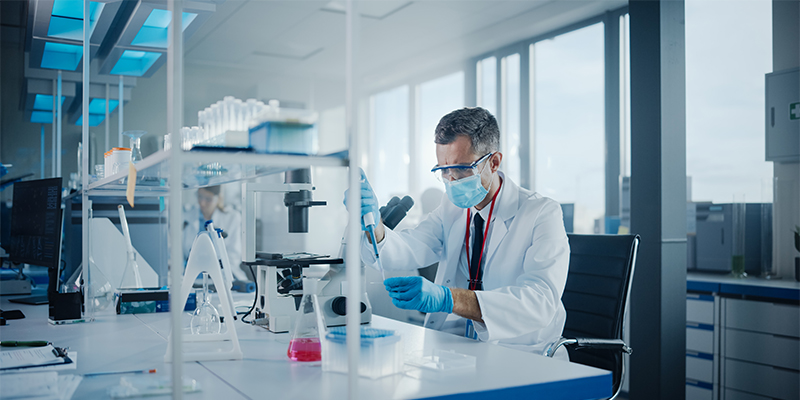Life sciences firms are under intense pressure right now to research and produce viable COVID-19 vaccines, and their workplaces and labs need to support their vital work. While many current pharmaceutical office trends will continue, new priorities are emerging that include accessible outdoor space, increased security and equalized workplace technology.
Despite the economic challenges of the past year, the life sciences industry is growing. Amidst the race to produce a COVID-19 vaccine as well as therapeutics, global demand is also skyrocketing for other much-needed medications. The message is clear: Companies must innovate better than ever, and faster than ever. In addition, they must stay ahead in an ongoing competition for talent.
In this dynamic industry, an effective workplace is more than just a backdrop to pharmaceutical innovation. Destination workplaces can actively inspire breakthroughs and boost productivity too, enabling life sciences leaders to bring fresh inspiration and momentum to their workforces.
From promoting health and well-being to ramping up investments in collaborative space and enhancing outdoor space, life sciences industry leaders are embracing creative design solutions that drive ingenuity.
Fueling Collaboration with Flexible Workplace Options
Even prior to the COVID-19 pandemic, activity-based workplaces (ABW) had been gaining favor in the life sciences industry. ABW offers unassigned desks for many – and sometimes all – employees, giving teams flexibility and the chance to collaborate in a mix of dynamic spaces. While some more traditional firms have been slower to adopt this approach, a “free address” trend is picking up more momentum in this industry every day.
Outside of laboratory personnel, many pharmaceutical workers experienced the industry-blind trend of working from home in 2020. It’s likely that the experience will help ABW pick up even more traction with the proof that pharmaceutical workers can be productive and engaged even when working remotely. After all, there’s nothing like a stay-at-home order to spark the human desire for in-person engagement, along with the opportunity to find the right location for the right task beyond the kitchen table.
Flexibility is now trumping territory. For example, one biopharmaceutical company was seeking more collaborative space. After studying how its different teams worked – both lab workers and office employees – corporate leadership at life sciences firms discovered that most of their teams’ work took place not at a desk, but in meeting and casual conversation spaces.
By evaluating how employees preferred to work, they learned the value of offering a menu of engagement spaces and activity-based workstations over the cookie-cutter layouts of days gone by.
Putting Safety and Well-being First
Pharmaceutical facilities have an inherent advantage over other industries when it comes to maintaining wellness practices designed to reduce the chance for disease spread. Workers in this industry generally have clinical and laboratory experience wearing face masks and engaging in thorough hand washing. And in terms of social distancing, life sciences firms have historically offered some of the least dense workspaces out there, a trend that’s likely to persist from the C-suite through to the lab even beyond COVID-19.
In lab facilities, there’s even less disruption. Antimicrobial materials and personal protective equipment are all part of a regular day on the job for staff scientists.
Furthermore, for most life sciences firms, a culture of wellness is already in place, and many locations offer meditation spaces, multifaith rooms and fitness centers, all of which have become standard fare for recruiting and keeping top talent.
Investing in Workplace Transformation
Innovative workplace design is set to become even more important in industry leaders’ fight to keep up with accelerating demand.
Consider the following emerging trends in life science campus design that are expected to gain momentum over the next couple of years:
- Greater, more accessible outdoor amenities. From walking trails to extended food service spaces, life sciences employees appreciate the mental and physical health benefits of usable outdoor space, plus it reinforces the wellness focus of their work. Meeting this desire with a more vibrant exterior can give firms a leg up in the competition for talent, while also enhancing public perception of their brand.
- Enhanced security. Amidst greater uncertainty in the world, feeling safe at work may be more valuable to a company’s workforce than ever. Plus, meeting the basic human need to feel safe means that a sense of security can allow employees to focus on their work, resulting in a boost in innovation. So some firms are stepping up security around the campus perimeter and lobby, supporting employee mental health and productivity, reducing potential disruption, and supporting cybersecurity initiatives in one fell swoop.
- Seamless collaboration with tech-enabled facilities. With more staff working remotely, sophisticated video-conferencing technology will make it easier for in-person teams to collaborate in real time with their off-site colleagues. Forward-looking pharma companies are increasingly investing in media rooms and other connective spaces to serve as hubs for productivity and engagement.
Established pharmaceuticals firms and hotshot startups alike have an opportunity now to create a destination workplace that delights employees, while making them feel safe and valued. In this time of historic pressure, that combination might be more potent than ever for inspiring scientific breakthrough.
This is the first piece in a series adapted from Wright Heerema Architects’ free ebook, The Destination Workplace. Read part two: Making the Office a Community-driven Workplace Destination and part three: How Custom Workplace Design can Improve Employee Health and Wellness.














